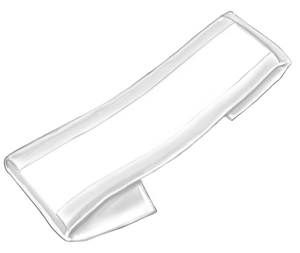MENSTRUAL PAD, maternity use, non sterile
Valid Article
MENSTRUAL PAD, maternity use
Definition
A non-sterile, non-deodorized, feminine hygiene pad that is held in place externally to absorb vaginal discharge after a delivery.
GMDN: Menstrual pad, unscented (40545)
Synonym
Maternity pad
Specifications
Norms
In the EU, sanitary pads are subject to consumer product regulations, which are less stringent. In the US, menstrual pads and adult incontinence diapers are regulated by FDA under Class I Medical Device.
Material
Typical layer construction of a disposable absorbent hygiene pad
The topsheet is a thin layer of perforated polypropylene and/or polyethylene non-woven. This layer is in direct contact with skin and transfers fluids quickly to the layer beneath, a high wicking ability is desirable.
Between the topsheet and the absorbent core, an optional acquisition layer (also called the distribution layer) may exist. This layer is composed of a cellulose patch and a polyester non-woven, and its function is to facilitate the spread of fluid evenly across the entire area and prevents fluid reflux by retaining the fluid, and helps fluid transfer to the next absorbent layer.
The absorbent core beneath the acquisition layer functions for fluid storage. This layer is composed of a blend of superabsorbent polymer (SAP) granules and fluff cellulose, which are encapsulated by cellulose or polypropylene non-woven. The SAP is typically made from sodium polyacrylate granules, and it transforms into a gel-like substance once it is wet, absorbing up to 30 times its weight liquid. The cellulose fluff helps to absorb liquid quickly and transfer to SAP.
The backsheet is typically made of a water-proof polyethylene or polypropylene film laminated with polypropylene non-woven. This layer prevents fluid from leaking. For feminine pads, the backsheet has adhesives to fix on cloth.
Technical specifications
- Resistant and breathable pads without adhesive
- Absorption capacity between 150 and 300 ml
- Large pads designed for use after delivery
- Unscented
- Non sterile, for single use
Dimensions
10 x 30 cm
Packaging & Labelling
Packaged by 20 or 50 pieces
Instructions for use
Wash hands before and after changing pads.
To be changed as frequently as required.
Storage
Store in a dry and light protected place.





![[PHYPMHMAPFE] FIXATION PANTS for pads, elastic net](/web/image/product.template/545965/image_256/%5BPHYPMHMAPFE%5D%20FIXATION%20PANTS%20for%20pads%2C%20elastic%20net?unique=c3dabdf)
![[PHYPMHMAPW5] MENSTRUAL PADS washable, set 1 L + 3 M + bag](/web/image/product.template/555525/image_256/%5BPHYPMHMAPW5%5D%20MENSTRUAL%20PADS%20washable%2C%20set%201%20L%20%2B%203%20M%20%2B%20bag?unique=e5b10ab)